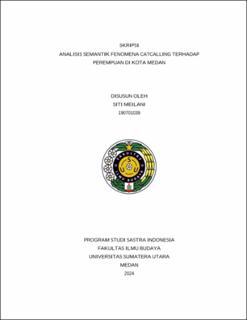| dc.description.abstract | This study aims to find the form of catcalling received by women in the city of Medan, especially in the Medan Tembung sub-district and to analyze the catcalling language with a linguistic approach. This study uses a semantic approach and Pierre Bourdieu's symbolic violence theory. The research method used is descriptive qualitative, which is a method to solve the problem of catcalling language with careful description. The data collection method used is the listening method. The tapping technique as a basic technique and the free listening technique as an advanced technique. The data collected is primary data, namely data obtained directly from respondents. Data analysis uses an interactive analysis method, namely data reduction, data presentation, and drawing conclusions. In this study, the researcher obtained 47 data, with various forms, including 1) Appearance Comments, 2) Onomatopoeic Sounds, 3) Vulgar Comments, 4) Calls, 5) Requests and Invitations, and 6) threats. Lexical semantic meaningful data, including synonymy (8 data), antonymy (1 data), hyponymy with subcategories of hyponym from complimenting physical (5 data), hyponym from nicknames (10 data), hyponym from facial expressions (6 data), hyponym from body parts (5 data), and hyponym from body shape (5 data). Grammatical meaningful data containing elements of affixation (11 data), reduplication (3 data), and composition (4 data). Referential meaningful data referring to objects (15 data), symptoms or events (3 data), reality (6 data), and properties (4 data). Non-referential meaningful data in the form of particles (1 data), prepositions (6 data), conjunctions (3 data), interjections (16 data), and phatic (9 data). Thus, this study has answered the formulation of the problem that has been determined by applying theories that are in line with verbal harassment. | en_US |


